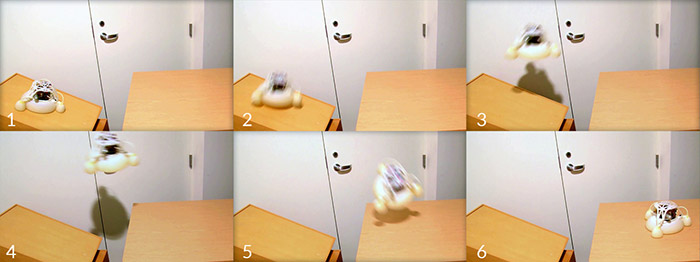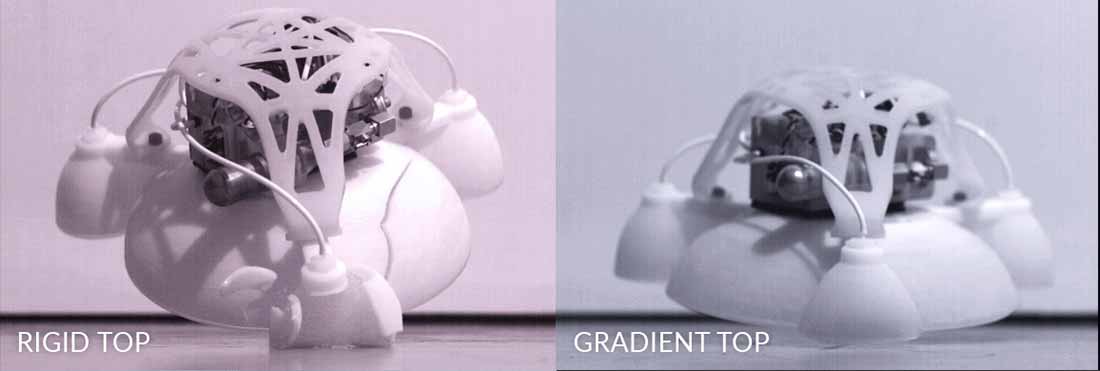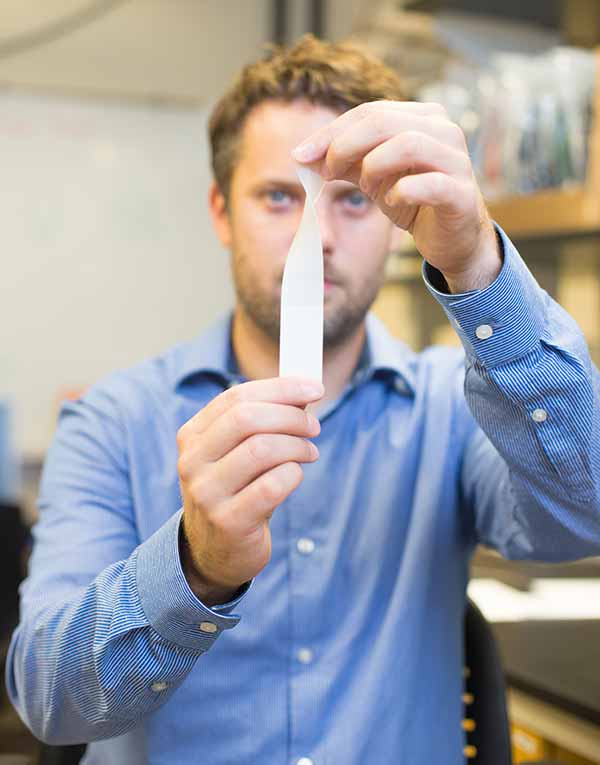3D-printed Robot is Hard at Heart, Soft on Outside
First of its kind robot is inspired by nature, capable of multiple jumps
Published Date
By:
- Ioana Patringenaru
Share This:
Article Content

Engineers at Harvard University and the University of California, San Diego, have created the first robot with a 3D-printed body that transitions from a rigid core to a soft exterior. The robot is capable of more than 30 untethered jumps and is powered by a mix of butane and oxygen. Researchers describe the robot’s design, manufacturing and testing in the July 10 issue of Science magazine.
“We believe that bringing together soft and rigid materials will help create a new generation of fast, agile robots that are more robust and adaptable than their predecessors and can safely work side by side with humans,” said Michael Tolley, an assistant professor of mechanical engineering at UC San Diego, and one of the paper’s co-lead authors with Nicholas Bartlett, a Ph.D. student in the Microrobotics Laboratory at Harvard, where the bulk of the work took place. Bartlett and Tolley designed, manufactured and tested the robot.
The idea of blending soft and hard materials into the robot’s body came from nature, Tolley said. For example, certain species of mussels have a foot that starts out soft and then becomes rigid at the point where it makes contact with rocks. “In nature, complexity has a very low cost,” Tolley said. “Using new manufacturing techniques like 3D printing, we’re trying to translate this to robotics.”

Soft robots tend to be slow, especially when accomplishing tasks without being tethered to power sources and other electronics, said Tolley, who recently co-authored a research review on soft robotics for Nature (Rus, Tolley, v. 521, pp. 467-475). Researchers hope that their work will allow rigid components to be better integrated within soft robots, which will then move faster without compromising the safety of the humans who would work with them.
In the case of the robot described in Science, rigid layers make for a better interface with the device’s electronic brains and power sources. The soft layers make it less vulnerable to damage when it lands after jumping.
The robot is made of two nestled hemispheres. The top hemisphere is like a half shell, 3D-printed in once piece, with nine different layers of stiffness, creating a structure that goes from rubber-like flexibility on the exterior to full rigidity near to core. Researchers tried several versions of the design and concluded that a fully rigid top would make for higher jumps. But a more flexible top was more likely to survive impacts on landing, allowing the robot to be reused. They decided to go with the more flexible design.

A challenging part of the process was designing around off-the-shelf materials available to 3D-print the robot, Tolley said. Specs provided by the manufacturers were not detailed enough, so he and his coauthors printed samples to test every single material they used. The data they collected allowed them to calculate the precise stiffness of the nine different layers in their robot’s top half. They used this information to simulate the performance of the robot and speed up the design process.
The bottom half of the robot is flexible and includes a small chamber where oxygen and butane are injected before it jumps. After the gases are ignited, this half behaves very much like a basketball that gets inflated almost instantaneously, propelling the robot into a jump. When the chemical charge is exhausted, the bottom hemisphere goes back to its original shape.
The two hemispheres surround a rigid core module that houses a custom circuit board, high-voltage power source, battery, miniature air compressor, butane fuel cell and other components. In a series of tests, the robot jumped two and a half feet (0.75 m) in height and half a foot (0.15m) laterally. In experiments, the robot jumped more than 100 times and survived an additional 35 falls from a height of almost four feet.
Tolley was a postdoctoral associate at Harvard when he did most of the work in this paper. He was hired at UC San Diego in fall 2014. In his lab at the Jacobs School of Engineering at UC San Diego, he borrows ideas from nature to design robots composed of soft materials; robots made by folding; and robots that self-assemble. He plans to further explore and expand the field of biologically inspired robotics in coming years.
Share This:
You May Also Like
Stay in the Know
Keep up with all the latest from UC San Diego. Subscribe to the newsletter today.



